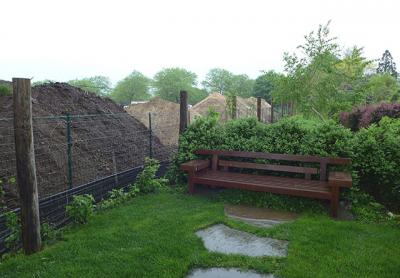Hedgerow’s Loss Lays Madoo Bare

In early April, a hedgerow that was the backdrop for plantings on the grounds of the Madoo Conservancy in Sagaponack was mistakenly destroyed by a landscaper clearing the way for a new house on neighboring property. With its annual cocktail party about to take place, the destruction has forced the conservancy to reshuffle its fund-raising priorities while searching for ways to mitigate the damage.
The Madoo Conservancy oversees a two-acre complex of historical buildings and gardens at 618 Sagg Main Street, which was curated by Robert Dash, a painter and writer who lived there from 1967 until his death in 2013.
Christopher Rice is the owner of the neighboring property, a nearly one-and-a-half-acre lot that has been in his family since the 1960s. Sagaponack Village had given him permission to demolish the old house there to make way for a new one.
The shared hedgerow that separated the parcels was so thick “you had no idea there was a house there,” Alejandro Saralegui, the executive director of Madoo, said. As construction got underway on Mr. Rice’s property, a landscaping company not only removed the portion of the hedgerow on Mr. Rice’s property but the majority of it on Madoo’s side.
“The property line had been staked correctly, but the contractor came and cleared everything,” Mr. Saralegui said. He estimated that the area of the destroyed hedgerow at Madoo was about 270 feet by 5 feet. Furthermore, he said, the hedgerow, which filled in naturally over the years, was one of a kind, a mix of native plants, invasives such as bittersweet “that were like 15 feet tall,” and even dead trees. “You can’t recreate a natural Sagaponack hedgerow,” he said. “It was essentially irreplaceable.”
The day the hedgerow was chopped down, Mr. Saralegui said he contacted Mr. Rice’s lawyer and said, “We’ve got a problem. What are you going to do?”
Mr. Rice, who lives in Princeton, N.J., said that although he isn’t sure what caused the landscapers to make the error, he and his wife, Liza, who is a certified master gardener, are working to rectify the problem. “We’re taking this seriously,” he said.
Mr. Saralegui acknowledged that the destruction was due to human error and was “not an example of a homeowner being a jerk.” But he also thinks the error is symptomatic of increasing disregard for natural surroundings in pursuit of development. “It happens more and more often,” Mr. Saralegui said. “People think of Madoo as this pretty garden, but there’s always been this idea of conservation involved with it, too. It’s been a bulwark against suburbanization.”
Soon after the hedgerow was removed, Mr. Saralegui contacted Marders and Broadview Gardens, companies he regularly works with, to get estimates of the cost of replacing it. The estimates came in between $50,000 to $80,000, he said.
A few weeks ago, the Rices joined Mr. Saralegui to walk through Madoo to get a better idea of the extent of the damage. Mr. Rice said he is in discussion with the landscaping companies as well as a group of master gardeners in New Jersey, regarding the best way to regrow the hedgerow. He and his wife are intent on making the new hedgerow “something that looks good on both sides,” he said.
Now, with the old hedgerow gone, visitors to Madoo see mounds of earth and other signs of construction on the neighbor’s property, which will also greet those who attend the conservancy’s annual fund-raising event, taking place from 6:30 to 8:30 p.m. on Friday, June 15, and Mr. Saralegui said the proceeds, which usually go to the organization’s general operating costs, would have to be redirected.
“Now it’s going to be about restoring Madoo,” he said. “But we’ll find a silver lining. The garden will have lost that authenticity, but we’ll be creative and do something really good with it.”
